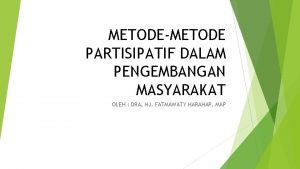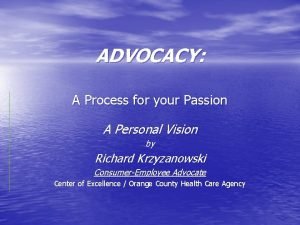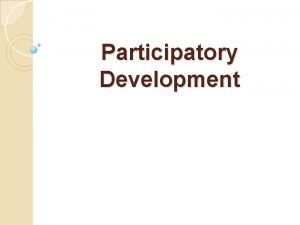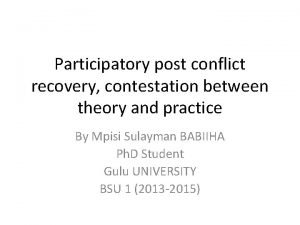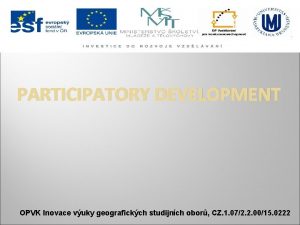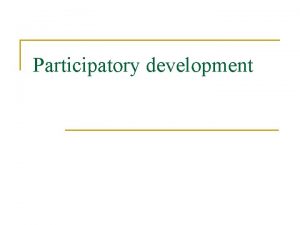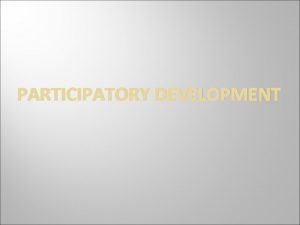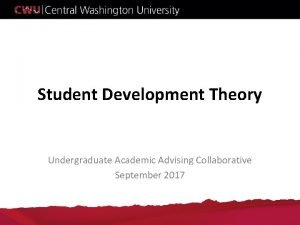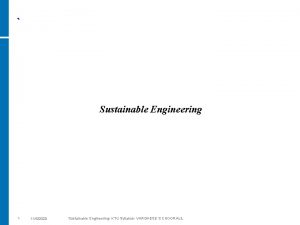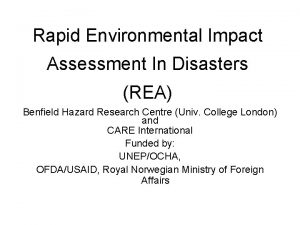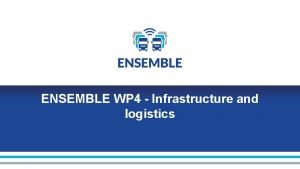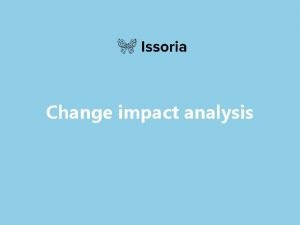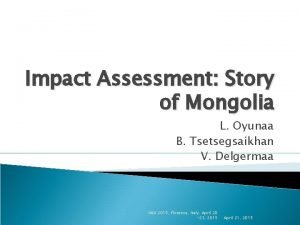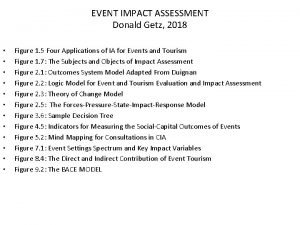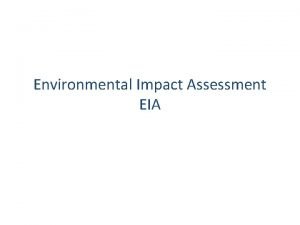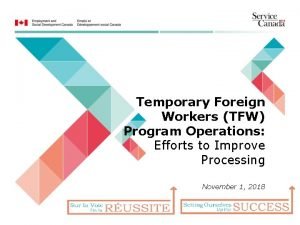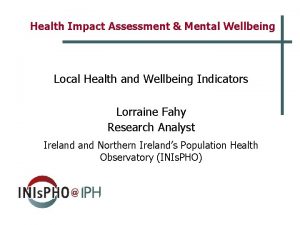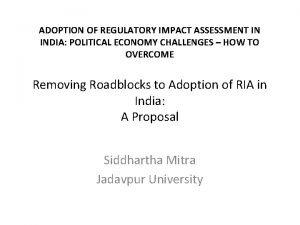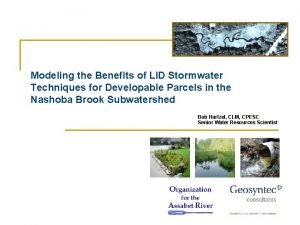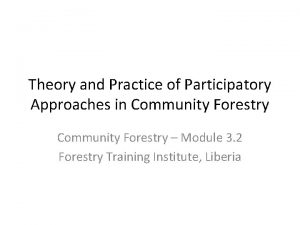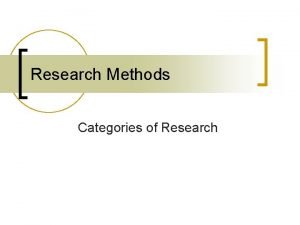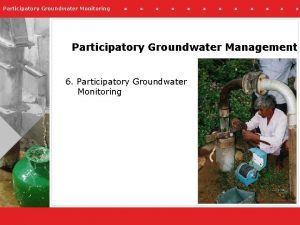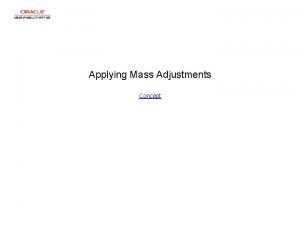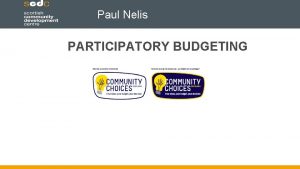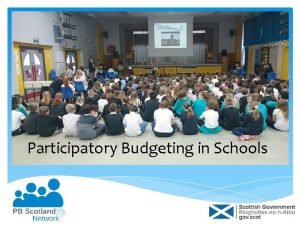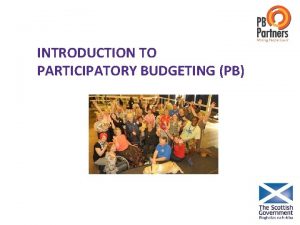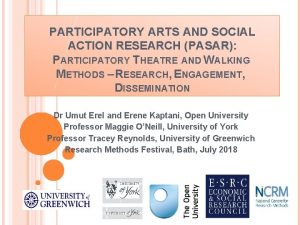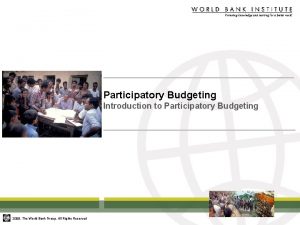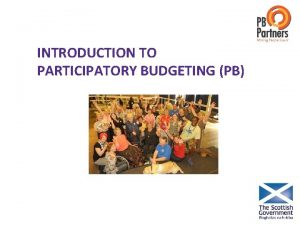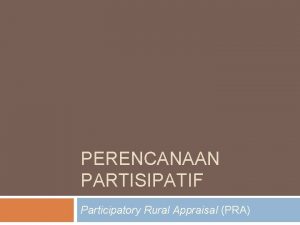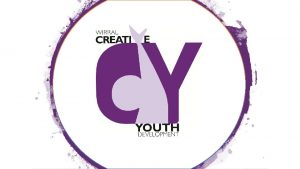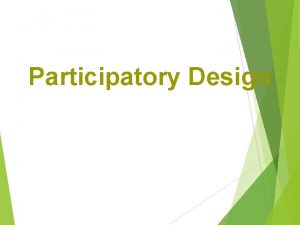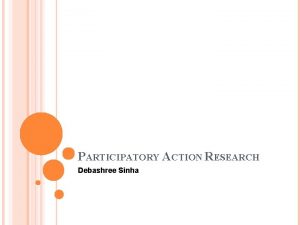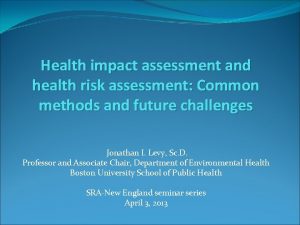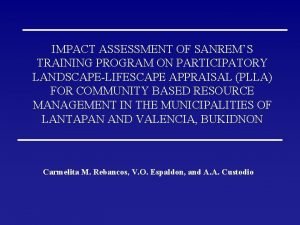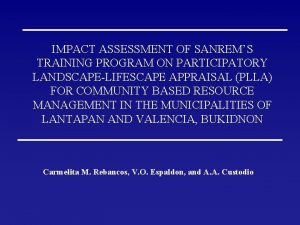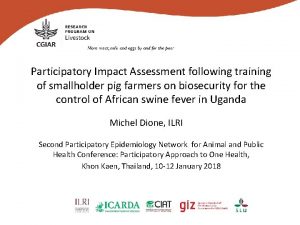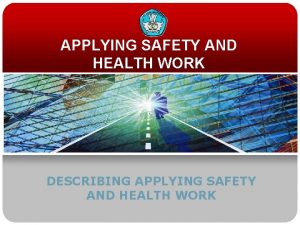Applying Participatory Health Impact Assessment for Advocating Development



























- Slides: 27

Applying Participatory Health Impact Assessment for Advocating Development of Healthy Public Policy in Thai Local Government Planning Processes Uraiwan Inmuong Lertchai Charerntanyarak Faculty of Public Health, Khon Kaen University, Thailand Peter Furu DBL- Centre for Health Research and Development Faculty of Life Sciences, University of Copenhagen, Denmark 1

Overview of presentation 1 Background 2 Objectives of the study 3 Methods 4 Study results 5 Discussion and conclusion 2

Background n Thailand decentralization countrywide 1999. n The local governments (LG) have legitimate role in city/town/village policy development and planning n Question: HOW can HIA be capable of advocating HPP within the LG policy& planning framework? 3

Background Thailand LG structure n n 75 Provincial Administrative Organizations 1, 129 Municipalities 6, 744 Sub-district Administrative Organizations (SAOs) The lowest and closer to people is the ‘SAO’ 4

Study site A small LG at Khon Kaen Province Northeast Thailand (400 km from Bangkok) Bueng Nium LG with 12 Villages and 8, 000 Population 5

Bueng Nium SAO governing structure n n 24 -LG Council Members (elected 2 members per village) 1 -President with 2 -Vice Presidents (elected) Office of LG Administration (29 -Officers) (Head : LG Permanent Secretary) Finance Div Civil Work Div Education Div Planning Div 6

Background Bueng Nium SAO planning framework National Guideline by Ministry of Interior 5 -year Strategic Plan (approved by LG Council) 3 -year Rolling Plan SAO Planning Committees (approved by LG Council) Annual Action Plan (approved by LG Council) • Sectoral oriented Village/Community SAO Implementing Divisions/ Sections 7

Background 5 -year strategic plan 2005 -2009 procedure (done in 2004) Procedure Stakeholders 1. Collections of problems and needs of community 2. Formulating draft strategic plan 1. Local development committee, community leaders and villagers 2. Local development supporting comm 3. Approval of draft strategic plan 3. Local development committee 4. Adoption strategic plan to SAO Council 4. SAO council members (Decision-makers) 8

Background 3 -year rolling plan 2007 -2009 procedure (done in 2006) Procedure Stakeholders 1. Collections of problems and needs of community 2. Formulating draft 3 -year plan 1. Local development committee, community leaders and villagers 2. Local development supporting comm 3. Approval of draft 3 -year plan 3. Local development committee 4. Adoption 3 -year plan to SAO Council 4. SAO council members (Decision-makers) 9

Background Components of the 3 -year Bueng Nium rolling plan (2007 -2009) 7 plans: 1. Poverty reduction plan 2. City and healthy community development plan 3. Human resources and quality society development plan 4. Grass root economy, trade and investment development plan 5. Tourism development plan 6. Natural resources and environmental management plan 7. Good governance development plan 1 -6 were later selected to be assessed health impact 10

Objectives 1. To apply participatory HIA tool for assessing an existing 3 -year SAO rolling development plan 2. To create participatory recommendation for building healthy public policy and planning frameworks for future SAO development plan 11

Methods (1) Applying HIA procedure in planning processes 1. Screening SAO 3 -year development plan (2007 -2009) (done in 2006) 2. Scoping 3. Full scale HIA 4. Appraisal of draft HIA report SAO 3 -year development plan (2008 -2010) (being done in May-July 2007) 5. Decision-making 6. Evaluation of HIA outcome 12

Methods (2) Research activities: (June 2006 – September 2007) HIA process 1. Screeni ng Method/Time Participatory HIA screening workshop (14 Sep 06) 2. Scoping Steering Committee HIA scoping workshop (20 Oct 06) 13

Methods (3) Research activities: (June 2006 – September 2007) HIA process 3. Full scale HIA Method/Time - Focus group discussion with key informants and key stakeholders ( Nov 06) -Full scale HIA workshop (15 Dec 06) 14

Methods (4) Research activities: (June 2006 – September 2007) HIA process Method/Time 4. Appraisal of HIA report - Steering Committee and key stakeholders meeting (14 Feb 07) 5. Decision-making - Proposed a set of recommendations for future improvement of the next 3 -year plan - Submitted the final HIA report to the Bueng Nium SAO (Apr 07) 6. Evaluation of HIA outcome - Participatory observations on the SAO planning activities - In-depth interviews and focus group discussion with key stakeholders 15

Study results (1) Population health status n from health authority records Indicators (2006) – Birth rate : 10. 05/1000 – Mortality rate : 0. 75/1000 – Population increasing rate : 9. 30/1000 n Key health problems (2006) – Diarrhoea – Diabetes mellitus /Hypertension n Vulnerable groups (2007) – – – 117 Elderly 28 Handicaps 5 AIDs patients 16

Study results (2) Number of communicable disease cases (Jan-Dec 06) PUO = Pyrexia of unknown origin Source: Khon Kaen hospital, Bueng Nium health center, 2007 17

Study results (3) Number of chronic non-communicable disease cases (April 2007) n n Number Diabetes mellitus (DM) 134 Hypertension (Ht) 27 DM and Ht 18 Toxic goiter 1 Total 180 18 Source: Bueng Nium health center, 2007

Study results (5) Health hazards perceived by local villagers n Health hazards – – – Intestinal pathogen Influenza virus Dengue virus Pesticide poisons Particulate matters from rice mill factory – Traffic 19

Study results (6) Health determinants viewed by local villagers 1 Individual & family determinants – age/gender/genetic/education/eating behavior/alcohol consumption/exercise/occupation/family structure 2 Environmental determinants Physical & Chemical environment – flooding/food hygiene/water quantity and quality/air quality/soil quality/recreation area/housing/community sanitation/infrastructure/industrial pollution Biological environment - plant insects attack/plant disease/ disease vector breeding place 20

Study results (7) Health determinants viewed by local villagers Social environment – religion/believe/local cultures/ traditions/community development activities/local regulations/community agreements/social cohesion/lottery buying / individual/family and community security/burglary/crime/drug abuse Economical environment 3 – income/debt/agricultural production price Institutional determinants – Sub-district health center services/health volunteer services/community development volunteer service/police service – SAO services: n solid waste collection n emergency response n community security services 21

Study results (8) Assessing health impacts from development plans Plan Changes in health outcomes Poverty reduction plan All positives except disease vector breeding place (organic composting) City and healthy community development plan All positives Human resources and quality society development plan All positives 22

Study results (9) Assessing health impacts from development plans Plan Changes in health outcomes Grass root economy, trade and investment development plan All positives Tourism development plan Most positives, but negatives to insect breeding place/community sanitation /environmental pollution Natural resources and environmental management plan All positives 23

Discussion and conclusion Benefits of HIA found: n Stakeholders responded of gaining knowledge and experiences on policy & planning development process n HIA well supported and fixed community participation problem in the planning development process n HIA fostered social cohesion between decisionmakers, community leaders, local officers and villagers n HIA made the local stakeholders know more about health hazard/risk/safeguard as well as how to do HPP 24

Discussion and conclusion HIA report was submitted to the SAO, some changes were recently observed: n Some recommendations were used for improvement of the SAO action plan 2007 n A set of recommendations based on HIA report were brought at stake and used for planning development process of the LG 3 -year plan (20082010), currently done by the Bueng Nium SAO during April-July 2007 25

Acknowledgements n Higher Education Commission, Ministry of Education, Thailand n The Graduate School, Khon Kaen University, Thailand n DBL- Centre for Health Research and Development Faculty of Life Sciences, University of Copenhagen, Denmark n IAIA and Swedish International Development Cooperation Agency n Bueng Nium SAO administrators, SAO council members, community leaders, SAO officers, health volunteers, community development volunteers, sub-district health center officers, and local people 26

27
 Participatory impact monitoring adalah
Participatory impact monitoring adalah Advocating guest passion
Advocating guest passion Participatory development
Participatory development Participatory development
Participatory development What is participatory development
What is participatory development What is participatory development
What is participatory development Participatory development
Participatory development Participatory development
Participatory development Willem van weperen
Willem van weperen Applying student development theory
Applying student development theory Ktu eia syllabus
Ktu eia syllabus Hp business continuity
Hp business continuity Cipd experience assessment examples
Cipd experience assessment examples Rapid environmental impact assessment in disaster
Rapid environmental impact assessment in disaster Viscoroute
Viscoroute Change impact assessment template
Change impact assessment template What is environmental impact assessment
What is environmental impact assessment Event impact assessment
Event impact assessment Eia processes
Eia processes Labour market impact assessment lmia online web application
Labour market impact assessment lmia online web application Mental wellbeing impact assessment
Mental wellbeing impact assessment Mental wellbeing impact assessment
Mental wellbeing impact assessment Regulatory impact assessment india
Regulatory impact assessment india Low impact development
Low impact development Low impact development
Low impact development Disadvantages of participatory planning
Disadvantages of participatory planning Pragmatism vs constructivism
Pragmatism vs constructivism Pra
Pra
